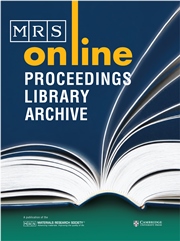No CrossRef data available.
Article contents
Microstructural Changes of a γ-TiAl Based Alloy with a Fully Lamellar Microstructure Due to Annealing at Elevated Temperatures
Published online by Cambridge University Press: 11 February 2011
Abstract
The changes of a fully lamellar microstructure caused by annealing at 700 and 800°C for up to 10,000 hours in air have been investigated for a Ti-46.5at.%Al-4at.%(Cr,Nb,Ta,B) sheet material. Changes in morphology as well as in chemical composition and volume fraction of constitutional phases were recorded by means of transmission electron microscopy. Thermodynamic equilibrium calculations performed with the software package ThermoCalc provide baseline information upon both the chemical composition and the amount of constitutional phases of the investigated multi-component alloy. It could be demonstrated that due to high cooling rates which are required to adjust a “defect-free” undisturbed fully lamellar microstructure, composition and amount of the α2 phase are far from the thermodynamic equilibrium. However, during high temperature exposure the composition as well as the amount of α2 phase move towards the values predicted by the calculation. Furthermore, former perfectly shaped γ/α2 lamellae interfaces are disturbed, α2 lamellae decompose and new phases appear instead. Dislocations emitted from dissolving α2 lamellae move into the γ lamellae. Mechanisms responsible for decomposition of lamellae and formation of new phases are explained by thermodynamic equilibrium calculations and diffusion considerations. Finally, results of tensile tests conducted at room temperature and 700°C on long-term annealed specimens are presented and discussed. This work is a basis for understanding microstructural changes and their impact on mechanical properties of γ-TiAl based alloys with a fully lamellar microstructure during service at elevated temperatures.
Information
- Type
- Research Article
- Information
- Copyright
- Copyright © Materials Research Society 2003

